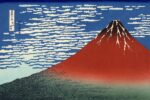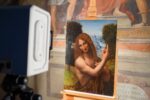Lo spazio del sacro
.jpg)
Architetti e Artisti per la Chiesa del Santo Volto di Gesù.
Comunicato stampa
LO SPAZIO DEL SACRO
Architetti e Artisti per la Chiesa del Santo Volto di Gesù
8 aprile - 17 giugno
a cura di Achille Bonito Oliva, Oliva Sartogo
Il museo Nivola, da sempre interessato al tema - cruciale nell’opera di Costantino Nivola a metà del Novecento - delle intersezioni tra arte e architettura, presenta una mostra su un progetto che ripropone questo rapporto nella contemporaneità. Nel 1998 gli architetti Piero Sartogo e Nathalie Grenon ricevono la commissione per il progetto del Santo Volto di Gesù, una nuova chiesa destinata a sorgere a Roma, nella zona della Magliana, quartiere ad alta densità abitativa con una lunga storia di lotte sociali ma anche di abusivismo, speculazione edilizia e violenza urbana. Un contesto stimolante e complesso, così come il lembo di terra assegnato all’edificio, un piccolo vuoto d’angolo stretto fra l’ampia via della Magliana e una sua strada trasversale.
Alla base della riflessione degli architetti è stata subito la consapevolezza del rapporto fra spazio pubblico e spazio del sacro, due ambiti che nel progetto vengono a coincidere. Il sagrato della chiesa diventa infatti una piazza, quella piazza che il quartiere - privo di luoghi di socializzazione - non aveva mai posseduto.
L’edificio si sviluppa a partire dalla croce, collocata all’esterno: nel punto di fuga sul quale convergono tutte le linee, in pianta e in alzato, articolando in due il volume dell’architettura, da una parte l’Aula Ecclesiale dall’altra la Parrocchia. Priva di campanile ma con una grande semicupola, la chiesa, costruita fra il 2003 e il 2006, accoglie un complesso di interventi artistici di grande suggestione, affidati a una serie di protagonisti dell’arte italiana: Carla Accardi, Chiara Dynys, Eliseo Mattiacci, Mimmo Paladino, Piero Ruffo, Marco Tirelli e Giuseppe Uncini.
Il progetto, fondato su una relazione diretta tra opera d’arte e spazio architettonico, esplora i legami tra espressione del sacro ed espressione artistica, così come tra dimensione etica e dimensione estetica. Come afferma Achille Bonito Oliva, “questo è il miracolo di una artitettura, frutto dell’intreccio di un contemporaneo che sceglie linguaggi di sconfinamento per parlare del nostro destino nelle forme di un nuovo umanesimo”.
La chiesa della Magliana da un lato chiama in causa la grande tradizione del cantiere medievale delle cattedrali, dall’altro si ricollega idealmente a due temi che attraversano l’arte e l’architettura del Novecento, quello della sintesi delle arti (l’integrazione fra arti visive e architettura) e quello dell’art sacré, il movimento di rinnovamento dell’arte sacra avviato in Francia agli inizi del Novecento e ripreso nel secondo dopoguerra con opere quali la cappella di Vence di Matisse o le chiese di Assy e di Audincourt.
La mostra ricostruisce il progetto presentando il grande plastico della chiesa proveniente dai Musei Vaticani, insieme a disegni e bozzetti degli interventi artistici e filmati. Una selezione di opere degli artisti coinvolti propone un confronto tra l’impegno di questi nel sacro e la ricerca da loro sviluppata autonomamente.
Piero Sartogo e Nathalie Grenon
Gli architetti Piero Sartogo e Nathalie Grenon, attivi con studi a Roma e New York, affrontano un ventaglio di temi progettuali ampio e diversificato: dalla grande pianificazione urbana (Masterplan del Complesso direzionale dell’Organismo Internazionale O.C.S.E. a Parigi, Insediamento Urbano Universitario a Bologna, nuovo comparto a Siena dalla Stazione al centro storico) all’organismo architettonico (la nuova Ambasciata d’Italia a Washington, il Palazzo per la sede della Banca di Roma a New York, diverse cantine di vinificazione in Chianti e Maremma negozi Bulgari a New York Tokyo Parigi etc.) al design industriale (collaborazioni con aziende quali Tiffany, Poltrona Frau, Fontana Arte, Richard Ginori ecc.). Come ha scritto Richard Meier, nella loro opera l’intreccio di “idee sulla creazione dello spazio, idee sulla materialità della superficie, idee sul rapporto fra la forma costruita e il tessuto urbano” mostra “un’evidente intelligenza dello specifico di ogni situazione, che permette loro di offrire alla cultura architettonica un contributo importante e un limpido messaggio.”
Artisti
CARLA ACCARDI, CHIARA DYNYS, ELISEO MATTIACCI, MIMMO PALADINO, PIERO RUFFO, MARCO TIRELLI, GIUSEPPE UNCINI.
Il Museo Nivola
Il Museo Nivola di Orani (Nuoro), sito al centro di un parco nel cuore della Sardegna, è dedicato all’opera di Costantino Nivola (Orani, 1911 – East Hampton, 1988), figura importante del contesto internazionale incentrato sulla “sintesi delle arti”, l’integrazione tra arti visive e architettura, e personaggio chiave negli scambi culturali tra Italia e Stati Uniti del secondo Novecento. Il museo possiede una collezione permanente di oltre duecento sculture, dipinti e disegni di Nivola e organizza mostre temporanee incentrate in prevalenza sul rapporto fra l’arte, l’architettura e il paesaggio.
www.museonivola.it
Main sponsor: Fondazione di Sardegna
Partner istituzionali: Regione Autonoma della Sardegna, Comune di Orani
Catalogo : Postmedia Books
SACRED SPACE
The Architects and Artists of the Church of the Santo Volto di Gesù
April 8–June 17
curated by Achille Bonito Oliva, Oliva Sartogo
Opening April 8 h 11.30
The Nivola museum, which has been interested from the beginning in the intersections between art and architecture (one of the main themes of Costantino Nivola’s work in the mid-20th century), presents an exhibition on a project that brought that relationship into the contemporary world. In 1998, the architects Piero Sartogo and Nathalie Grenon were commissioned to design the church of the Santo Volto di Gesù, a new church in the Magliana neighborhood of Rome, a highly populated area with a long history of social struggle as well as unauthorized building, property speculation, and urban violence. A context as stimulating and complex as the strip of land allocated for the building, a small, narrow corner plot between the broad Via della Magliana and one of its side streets.
The architects’ thinking was based from the start on awareness of the relationship between public space and religious space, two spheres brought together in the project. Indeed, the church parvis became a piazza, the public square that the neighborhood—lacking in social spaces—had never had.
The building develops starting from a cross located outside, in the vanishing point where all of the lines, in both plan and elevation, converge, articulating the volume of the architecture in two parts: the Aula Ecclesiale and the Parrocchia. Lacking a bell tower but boasting a large half-dome, the church, built between 2003 and 2006, hosts a group of highly evocative artworks by a number of leading figures in Italian art: Carla Accardi, Chiara Dynys, Eliseo Mattiacci, Mimmo Paladino, Piero Ruffo, Marco Tirelli, and Giuseppe Uncini.
The project, based on a direct relationship between art and architectural space, explores the links between religious and artistic expression, as well as between ethics and aesthetics. As described by Achille Bonito Oliva, “it is a miracle of artitecture, the fruit of an interweaving wrought by a contemporary who chooses the language of crossing borders to talk about our destiny in the form of a new humanism.”
The church of the Magliana cites the great tradition of medieval cathedral worksites and creates an ideal link between two themes of 20th-century art and architecture: on the one hand, the synthesis of the arts (integration between the visual arts and architecture) and on the other, art sacré, the early 20th-century French movement for the modernization of religious art that was revived in the postwar period in works such as Matisse’s Vence Chapel and the churches of Assy and Audincourt.
The exhibition reconstructs this project through a large plastic model of the church from the Vatican Museums, drawings and models of the artworks, and films. A selection of works by the artists who were involved in the project offers an opportunity to compare their religious work with that developed independently.
Piero Sartogo and Nathalie Grenon
The architects Piero Sartogo and Nathalie Grenon, who have offices in Rome and New York, have tackled a wide and diverse range of design themes: from large-scale city planning (the master plan for the administrative complex of the international organization OECD in Paris, a new urban campus for the University of Bologna, a new urban space in Siena from the train station to the historical center) to architecture (the new Italian Embassy in Washington, the Bank of Rome headquarters in New York, various wineries in Chianti and Maremma, and Bulgari stores in New York, Tokyo, and Paris, to list just a few) and industrial design (collaborations with companies such as Tiffany & Co., Poltrona Frau, Fontana Arte, Richard Ginori, and more). To paraphrase Richard Meier, in their work, the interweaving of ideas about the creation of space, ideas about the materiality of the surface, and ideas about the relationship between built form and the urban fabric reveals an acute understanding of the specifics of each situation that allows them to make an important contribution to architectural culture and express a clear message.
Artists
CARLA ACCARDI, CHIARA DYNYS, ELISEO MATTIACCI, MIMMO PALADINO, PIERO RUFFO, MARCO TIRELLI, GIUSEPPE UNCINI.
The Museo Nivola
The Museo Nivola in Orani (Nuoro), located in the middle of a park in the heart of Sardinia, is devoted to the work of Costantino Nivola (Orani, 1911–East Hampton, 1988), an important figure in the international movement for the “synthesis of the arts” (the integration of the visual arts and architecture) who played a critical role in the cultural exchange between Italy and the United States in the second half of the 20th century. The museum has a permanent collection comprising more than 200 sculptures, paintings, and drawings by Nivola and organizes temporary exhibitions focused primarily on the relationship between art, architecture, and the landscape.
www.museonivola.it
Main sponsor: Fondazione di Sardegna
Institutional Partners: Autonomous Region of Sardinia, City of Orani
Catalogue: Postmedia Books



